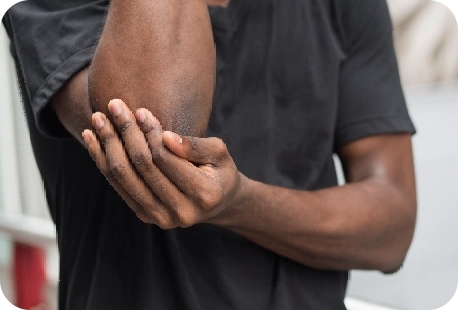

Physicians
Search

GENERAL INFORMATION
Puget Sound Orthopaedics (PSO) elbow experts offer the most current treatment options for bone- and joint-related elbow injuries, which may or may not include surgery. When surgery is necessary, PSO surgeons use state-of-the-art surgical techniques and new implant technology that can provide significant reduction in pain, restored functional ability and an improvement in their patients’ quality of life.
Your elbow is a joint that bends and straightens like a hinge. It also performs an important function in the rotation of the forearm, providing the ability to turn your palm up (much like holding out your hand to accept money) and down (in the instance of patting the head of your pet or typing on a keyboard).
The elbow is made up of three (3) bones: the humerus (upper arm bone), radius and ulna (located in the lower arm between the wrist and elbow). Together, the bones, ligaments, tendons and muscles create a bony architecture that holds the arm together.
Have you ever hit the bony point of your elbow and felt a sharp electrical pain, tingling and numbing sensation? That’s your olecranon or funny bone which is located at the end of the ulna. You’re actually hitting the ulnar nerve that crosses the medial (inner) part of the elbow joint. The olecranon bursa also contains a thin, slippery sac of lubricating fluid that aids movement in the joint.
An injury to the elbow is painful and limits the affected arm’s movement in everyday activities such as mowing the lawn, driving a car or carrying a child or bags of groceries. Falling on an oustretched arm can result in fracturing the radial head or olecranon. A distal humerus fracture (in the lower end of the upper humerus bone that connects to the elbow) often results in several broken pieces, referred to as a comminuted fracture.
Overuse injuries of the elbow typically afflict athletes who repeatedly throw a ball or other sports apparatus. This injury gradually worsens over time. Overthrowing injuries affect the tendons (flexor tendinitis) and ligaments (UCL injury) of the elbow. Stress fractures, which are tiny cracks located in the bone, can also occur when muscles around the elbow are not able to absorb the shock of repetitive use.
Although uncommon, adult elbow dislocations usually occur when falling on an outstretched hand or in a car accident when bracing for impact. However, partial dislocations, referred to as nursemaid’s elbow, are more common in children.
Seek treatment if you are experiencing any of the following elbow symptoms:
Your doctor will discuss all treatment options with you. The best treatment for your injury or condition will be determined in combination with your overall health.
There are several nonoperative treatment options for elbow pain. These might include immobilizing the afflicted elbow by applying a cast or using a sling, physical therapy or pain management in the form of over-the-counter or prescribed medications and/or anti-inflammatories. If surgery is necessary, PSO elbow specialists can perform a wide variety of procedures ranging from minimally invasive to major reconstruction.
Our specialties extend beyond what you see here. If you have a special need, make an appointment with us!